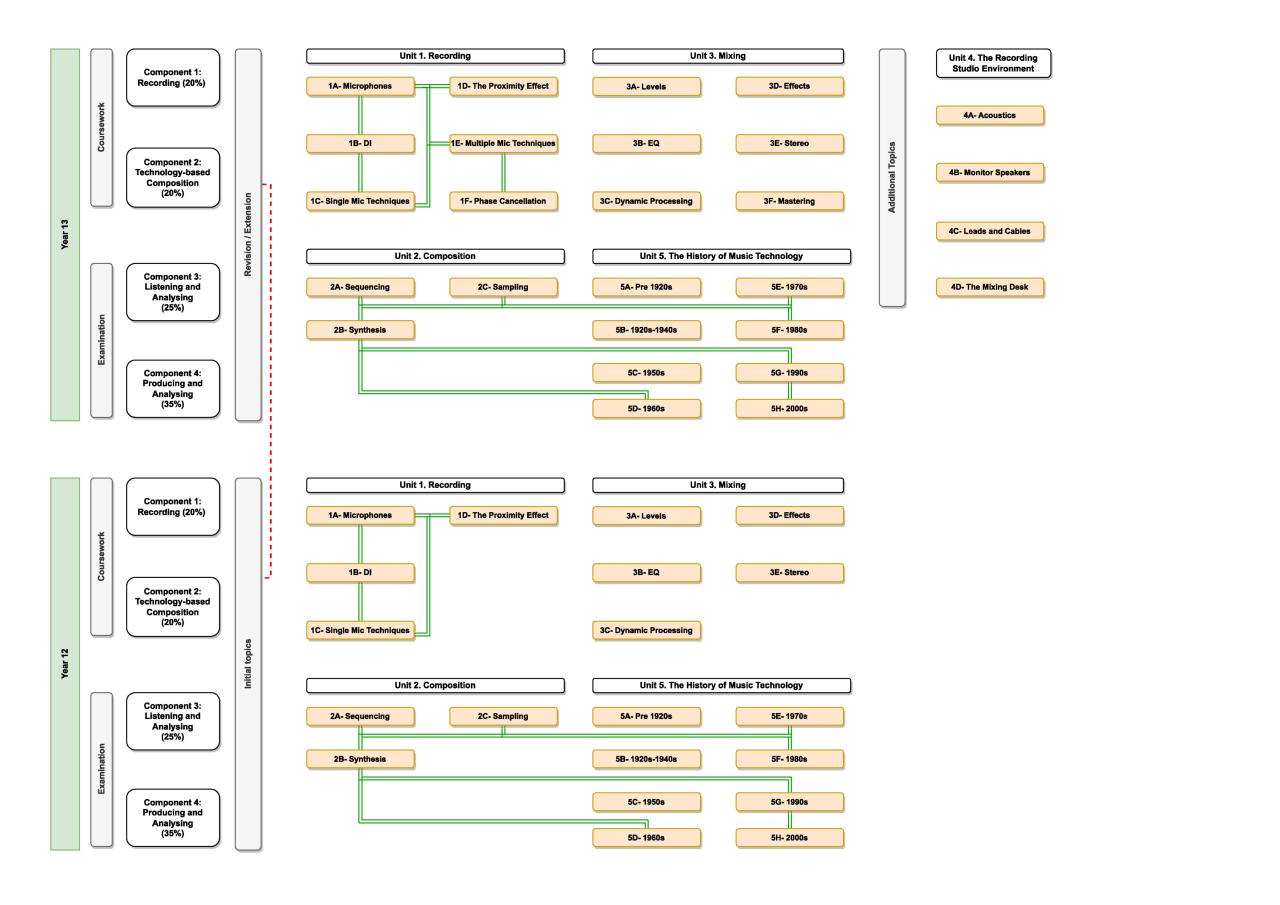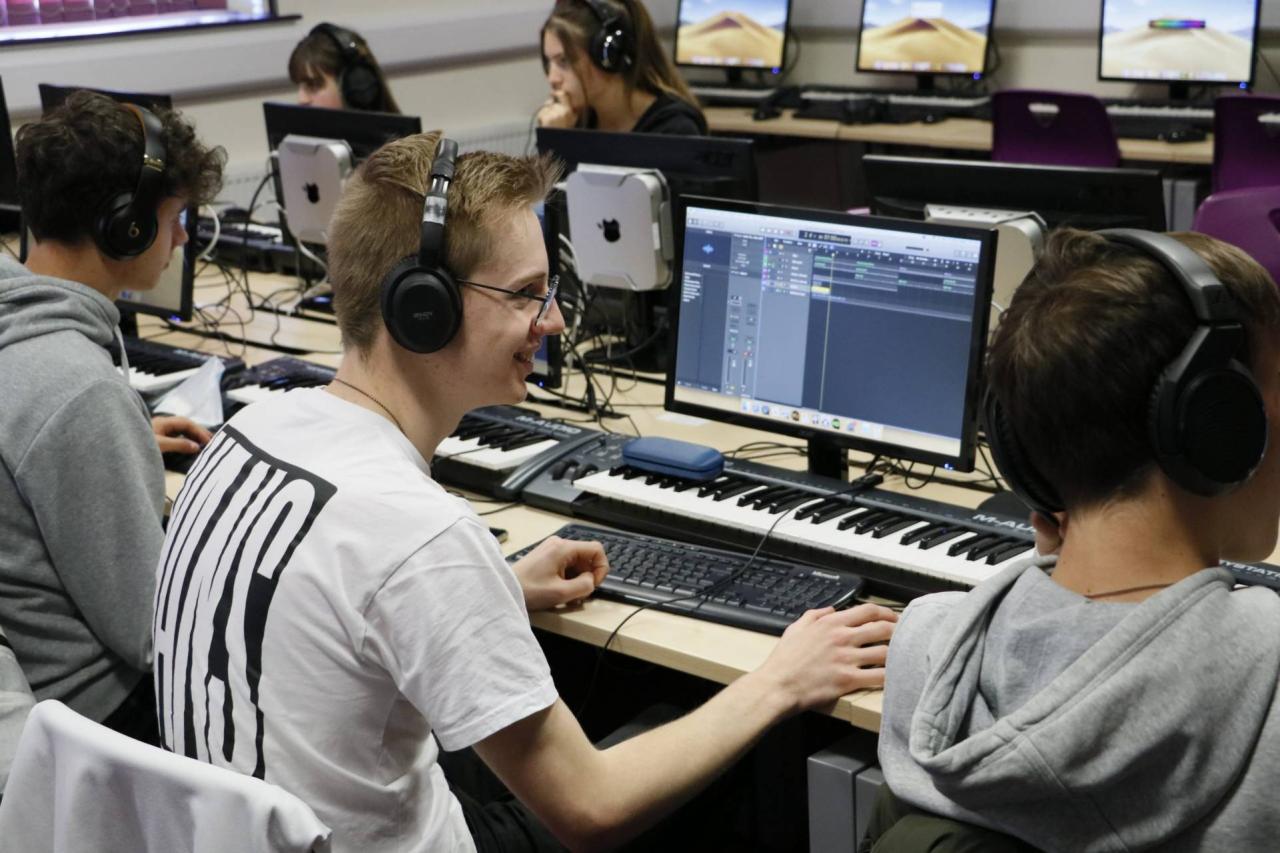Music Technology Curriculum: A Guide to Modern Music Creation
Music technology curriculum, a cornerstone of contemporary music education, opens a world of possibilities for aspiring musicians and sound engineers. This curriculum provides a comprehensive exploration of the tools, techniques, […]

Music technology curriculum, a cornerstone of contemporary music education, opens a world of possibilities for aspiring musicians and sound engineers. This curriculum provides a comprehensive exploration of the tools, techniques, and concepts that have revolutionized music creation, performance, and distribution.
From the historical evolution of music technology to the latest advancements in artificial intelligence and virtual reality, this curriculum delves into the core principles of digital audio workstations (DAWs), audio signal processing, MIDI, and sampling. It empowers students to master the art of recording, editing, mixing, and mastering audio, while also exploring the creative potential of sound design and music production techniques.
Core Concepts in Music Technology
Music technology encompasses a vast array of tools and techniques that have revolutionized the way music is created, produced, and consumed. Understanding the fundamental concepts of music technology is crucial for anyone aspiring to be a music producer, sound engineer, or simply an informed listener.
Digital Audio Workstations (DAWs)
Digital Audio Workstations (DAWs) are software applications that provide a comprehensive environment for recording, editing, mixing, and mastering audio. They act as the central hub for all aspects of music production, offering a wide range of features and tools.
- Recording: DAWs allow users to record audio from microphones, instruments, or other audio sources directly into the software. This enables capturing live performances, creating multi-track recordings, and building up musical arrangements.
- Editing: DAWs offer a variety of tools for editing audio, including cutting, pasting, trimming, and manipulating the timing and pitch of audio clips. This allows for precise adjustments to the recorded material, ensuring a polished and professional sound.
- Mixing: DAWs provide a virtual mixing console where users can adjust the levels, panning, and effects of individual audio tracks. This process involves blending the different elements of a song together to create a cohesive and balanced sound.
- Mastering: Mastering is the final stage of audio production, where the overall volume, dynamics, and frequency response of a song are optimized for distribution. DAWs offer tools for mastering, such as equalization, compression, and limiting, which enhance the sonic quality of the final product.
Some popular DAWs include Ableton Live, Logic Pro X, Pro Tools, FL Studio, and Cubase, each with its own unique features and workflow.
Audio Signal Processing
Audio signal processing refers to the manipulation of audio signals using electronic circuits or software algorithms. This process involves altering the characteristics of audio signals, such as their amplitude, frequency, and time domain, to achieve desired effects.
- Equalization (EQ): EQ involves adjusting the frequency content of an audio signal. It allows users to boost or cut specific frequencies, shaping the overall tone and character of the sound.
- Compression: Compression reduces the dynamic range of an audio signal, making quieter parts louder and louder parts quieter. This technique is commonly used to even out the volume of a track, making it more consistent and impactful.
- Reverb: Reverb simulates the effect of sound reflecting off surfaces in a space. It adds depth and spaciousness to audio, creating a sense of atmosphere and realism.
- Delay: Delay creates echoes or repetitions of an audio signal. It can be used to add texture, rhythm, and depth to a sound, or to create more complex sonic effects.
These are just a few examples of audio signal processing techniques. Many other effects, such as distortion, chorus, and phasing, are used in music production to create a wide range of sonic possibilities.
MIDI
MIDI (Musical Instrument Digital Interface) is a communication protocol that allows electronic musical instruments and computers to communicate with each other. It transmits information about musical notes, timing, and other musical parameters, rather than the actual audio signal itself.
- MIDI Controllers: MIDI controllers are hardware devices, such as keyboards, drum pads, and control surfaces, that allow users to input MIDI data into a DAW or other music software.
- Virtual Instruments: Virtual instruments are software programs that simulate the sound of real instruments, such as pianos, guitars, drums, and synthesizers. They are controlled by MIDI data, allowing users to play and manipulate the instruments virtually.
- Sequencing: MIDI data can be used to create sequences, which are patterns of notes and timing information. These sequences can be used to program drum beats, create melodies, or control the playback of virtual instruments.
MIDI is a powerful tool for music production, enabling users to create and manipulate musical ideas with a high level of precision and flexibility.
Sampling
Sampling is the process of recording and reusing a portion of an existing audio signal, called a “sample,” in a new musical context.
- Sample Libraries: Sample libraries are collections of pre-recorded samples that can be used in music production. They offer a wide variety of sounds, from drums and instruments to vocals and sound effects.
- Sampling Techniques: Sampling techniques involve manipulating the pitch, tempo, and other characteristics of samples to create new sounds and textures. This process can involve chopping, looping, and layering samples to create complex and innovative musical arrangements.
- Influence on Music: Sampling has had a profound impact on music, particularly in genres like hip-hop, electronic music, and experimental music. It allows producers to create unique sounds and textures by blending and manipulating existing audio material.
Sampling has become an integral part of modern music production, allowing for creative exploration and sonic innovation.
Software and Hardware in Music Production
Music production relies heavily on both software and hardware components, each playing a vital role in the creative process.
Software
Software tools, such as DAWs, plugins, and virtual instruments, provide the digital infrastructure for music creation.
- DAWs: As discussed earlier, DAWs are the core software applications for music production, providing a comprehensive environment for recording, editing, mixing, and mastering audio.
- Plugins: Plugins are software modules that add specific effects, instruments, or processing capabilities to a DAW. They extend the functionality of a DAW, allowing producers to achieve a wide range of sonic possibilities.
- Virtual Instruments: Virtual instruments are software simulations of real instruments, offering a wide variety of sounds and playing styles. They allow producers to create realistic instrument sounds without needing to physically own the actual instruments.
Hardware
Hardware components, such as audio interfaces, microphones, speakers, and controllers, provide the physical connection between the digital world and the real world.
- Audio Interfaces: Audio interfaces are devices that connect microphones, instruments, and other audio sources to a computer. They convert analog audio signals to digital signals, allowing them to be recorded and processed by a DAW.
- Microphones: Microphones capture sound waves and convert them into electrical signals. Different types of microphones are designed for different applications, such as recording vocals, instruments, or ambient sound.
- Speakers: Speakers reproduce audio signals, allowing users to hear the results of their music production. Different types of speakers are designed for different purposes, such as monitoring, mixing, or listening to music.
- MIDI Controllers: MIDI controllers are hardware devices that allow users to input MIDI data into a DAW. They can be used to control virtual instruments, trigger samples, and automate parameters within a DAW.
| Type of Music Software | Applications |
|---|---|
| DAWs | Recording, editing, mixing, mastering |
| Plugins | Effects, instruments, processing |
| Virtual Instruments | Simulating real instruments |
| Sample Libraries | Providing pre-recorded sounds |
| Notation Software | Creating and editing musical scores |
Music Technology in Performance: Music Technology Curriculum

Music technology plays a crucial role in modern live performances, transforming the way musicians interact with their audiences and shaping the soundscape of contemporary music. From electronic instruments to elaborate sound systems and captivating lighting designs, music technology enhances the sonic and visual experience, creating immersive and unforgettable performances.
Integration of Live Instruments and Electronic Music
The integration of live instruments and electronic music has become increasingly prevalent in modern music, allowing musicians to blend traditional sounds with cutting-edge electronic elements. This fusion is achieved through the use of MIDI controllers and audio processing techniques.
- MIDI Controllers: MIDI (Musical Instrument Digital Interface) controllers serve as a bridge between live instruments and electronic music software. These devices, ranging from keyboards to drum pads, translate the musician’s performance into digital signals that can be interpreted by software synthesizers, samplers, and other electronic instruments. MIDI controllers allow musicians to control various parameters of electronic sounds, such as pitch, volume, and effects, in real-time, seamlessly blending acoustic and electronic elements.
- Audio Processing: Audio processing techniques are essential for shaping the sound of both live instruments and electronic music. These techniques include equalization (EQ), compression, and effects, which are used to enhance the clarity, dynamics, and overall sonic quality of the performance. For instance, EQ can be used to sculpt the frequency response of an instrument, while compression can even out the volume levels and enhance the perceived loudness. Effects such as reverb, delay, and chorus can add depth, dimension, and sonic texture to the performance.
Impact of Music Technology on Contemporary Music Genres
Music technology has profoundly impacted the evolution of various contemporary music genres, shaping their sound, production techniques, and overall aesthetic.
- Electronic Dance Music (EDM): EDM genres like house, techno, and trance rely heavily on music technology for their creation and performance. Electronic instruments, such as synthesizers, drum machines, and samplers, are the primary tools for generating the distinctive sounds of these genres. Software-based digital audio workstations (DAWs) allow producers to create complex arrangements, manipulate sounds, and mix and master tracks with precision. Live performances often feature DJs using turntables, samplers, and software to manipulate and blend electronic sounds, creating an immersive and interactive experience for the audience.
- Hip-Hop: Hip-hop music has been closely intertwined with music technology since its inception. The use of samplers and drum machines has been integral to the genre’s sound, allowing producers to create beats and loops from existing recordings. Digital audio workstations (DAWs) have become standard tools for hip-hop producers, enabling them to create and manipulate beats, record vocals, and mix and master tracks. Live hip-hop performances often incorporate elements of DJing, turntablism, and electronic instruments, adding a dynamic and interactive element to the show.
- Pop: Pop music has embraced music technology to create catchy melodies, elaborate arrangements, and polished productions. Electronic instruments, such as synthesizers and drum machines, are frequently used to create the signature sounds of pop music. Auto-tune, a software plugin that corrects pitch, has become a ubiquitous tool in pop music, allowing artists to achieve a smooth and polished vocal sound. Live pop performances often feature elaborate stage designs, lighting effects, and video projections, creating a visually stunning and immersive experience for the audience.
The Future of Music Technology

The landscape of music creation, performance, and distribution is rapidly evolving, driven by the relentless advancements in technology. Emerging trends such as artificial intelligence (AI), virtual reality (VR), and augmented reality (AR) are poised to revolutionize how music is made, experienced, and consumed. This section delves into these transformative technologies and explores their potential impact on the future of music.
AI in Music Creation
AI is increasingly being used in music creation, offering innovative tools and techniques that expand the boundaries of musical expression. AI algorithms can generate melodies, harmonies, and rhythms, providing musicians with a powerful creative partner.
- AI-powered music composition: AI algorithms can analyze vast amounts of musical data, learning patterns and styles to create original compositions. Platforms like Amper Music and Jukebox allow users to generate custom music tracks based on specific parameters, such as genre, mood, and instrumentation.
- AI-assisted music production: AI tools can assist musicians in various aspects of music production, including mixing, mastering, and sound design. For example, LANDR’s AI-powered mastering service can automatically optimize the loudness and clarity of tracks, while tools like Melodyne can automatically correct pitch and timing imperfections in vocal recordings.
VR and AR in Music Performance
VR and AR technologies are transforming the way music is experienced, blurring the lines between the physical and digital realms. These technologies create immersive and interactive environments that enhance the audience’s engagement with music.
- VR concerts and performances: VR concerts allow audiences to experience live music in virtual environments, offering a level of immersion and interactivity that is not possible in traditional settings. For example, the virtual concert series “VR Together” features live performances by renowned artists in virtual worlds, allowing audiences to interact with each other and the performers in new and exciting ways.
- AR-enhanced live music experiences: AR can augment live music performances by overlaying digital content onto the real world, creating a more engaging and interactive experience for the audience. For instance, AR applications can display lyrics, artist information, and interactive elements on the stage, enhancing the audience’s understanding and appreciation of the music.
Music Distribution and Consumption, Music technology curriculum
AI, VR, and AR are also transforming how music is distributed and consumed. These technologies enable new forms of personalized music experiences and create opportunities for independent artists to reach wider audiences.
- Personalized music recommendations: AI algorithms can analyze listening habits and preferences to provide personalized music recommendations. Streaming platforms like Spotify and Apple Music use AI to create curated playlists and suggest new artists and songs based on individual tastes.
- Interactive music experiences: VR and AR can create immersive and interactive music experiences that go beyond traditional listening. For example, VR music apps allow users to explore virtual worlds where they can interact with other users, attend virtual concerts, and discover new music.
A Futuristic Music Technology Application
Imagine a music creation platform powered by AI that allows users to create and share music in a collaborative and immersive virtual environment. This platform would feature:
- AI-powered music generation: Users could generate melodies, harmonies, and rhythms using AI algorithms, experimenting with different styles and genres.
- Virtual music studios: Users could collaborate with others in virtual music studios, sharing instruments, effects, and ideas in real-time.
- Immersive music experiences: Users could create and share music in immersive virtual environments, where they could interact with other users, attend virtual concerts, and explore different musical landscapes.
- Personalized music recommendations: AI algorithms would analyze user preferences and listening habits to provide personalized music recommendations and connect users with other musicians who share similar tastes.
This futuristic music technology application would empower musicians and listeners alike, fostering a more collaborative and engaging music ecosystem.
Summary

By embracing a music technology curriculum, students gain the skills and knowledge necessary to navigate the ever-evolving landscape of music production. They develop a deep understanding of the creative and technical aspects of music, equipping them to thrive in a world where technology plays a pivotal role in shaping the future of sound.
A music technology curriculum can cover a wide range of topics, from the fundamentals of sound and audio production to the latest advancements in music software and hardware. It’s also important to consider how bespoke technology, like that offered by smartorders.ca , can be integrated into the curriculum to give students hands-on experience with real-world applications.
By incorporating these elements, music technology programs can equip students with the skills and knowledge they need to succeed in today’s rapidly evolving industry.





